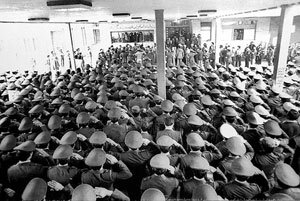Air Force Day: the day the Shah’s commanders decided to stand by their nation

TEHRAN – On February 8, 1979, a group of Air Force commanders from the Shah's regime went to Imam Khomeini's residence to pledge their allegiance to him, announcing that they were joining the widespread revolutionary movement.
Many Iranian Air Force personnel, known as "Homafaran," had taken specialized courses in the United States, such as electronics and mechanics, prior to the Islamic Revolution in 1979. Several of them had joined the revolution before Imam Khomeini's return to Iran, weeks prior, and some had even visited Imam Khomeini's residence while he was in exile in Neauphle-le-Château, a suburb of Paris, but were arrested and exiled upon returning to the country.
But on that particular day in winter, a group of these Air Force staff secretly went to Imam Khomeini's temporary residence at Alawi School in eastern Tehran, not caring about the fact that they could face the same consequences their peers did in the past.
Reportedly, the personnel wore casual clothes on the way to Alawi School to avoid the imperial guard and changed back into their uniforms once inside the school. They proceeded in order and then entered the meeting with Imam. They pledged their allegiance to the revolution and its highly popular leader in a communiqué they read aloud.
During the meeting, due to threats against the Homafarans, security checks were carried out to prevent photography. However, Hossein Partovi, a photographer with the Tehran-based Kayhan newspaper, was permitted to take photos from behind the troops to protect the Homafarans' identities from the oppressive Shah regime.
Imam’s remarks at the meeting:
In a short speech, Imam Khomeini thanked the Air Force personnel, referring to them as soldiers of Imam Mahdi, the 12th and only living Shia Imam. He expressed his gratitude for the efforts made by the Air Force and Army personnel towards the establishment of an Islamic government.
"As you have proclaimed until now, you were serving Taghut, which has decimated our entire being; Taghut, which has emptied our treasury and turned us into slaves at the service of foreigners. From now on, you are in the service of the Imam Mahdi, may God's peace be upon him, and the glorious Qur'an, which has guaranteed the well-being of all humanity; the glorious Qur'an, which assures well-being in this world and the hereafter to anyone who remains under its banner; the glorious Qur'an, which advocates freedom and independence. We are all followers of the glorious Qur'an and Islamic precepts and ordinances. All of us, including the clerics, are grateful to you," Imam Khomeini stated at the meeting.
"We want to emancipate our country and cleanse it of all oppression. We want the armed forces to be free from control by Israel or America," Imam Khomeini added.
In their communique, the Air Force staff expressed hope that the remaining personnel still serving in the Shah regime’s military would follow in their footsteps, understand their duty, and join the nation. They aspired to be free and make their beloved country independent.
The Air Force staff's pledge of allegiance occurred just three days before the victory of the Islamic Revolution. It significantly accelerated the subsequent events, especially the army's declaration of neutrality and its eventual turning against the interim Shahpour Bakhtiar regime.
After the meeting:
Following Kayhan newspaper's afternoon front-page coverage of the meeting, with the headline "Air Force personnel pledged allegiance to Imam Khomeini," Shahpour Bakhtiar, the last Shah's Prime Minister, attempted to deny that it had occurred.
Kayhan also published a photo of the meeting, depicting a group of Homafarans in uniforms at the Imam's residence; however, the picture showed the backs of the troops to protect their identities. The Bakhtiar regime declared the photo a "montage" and issued an arrest warrant for the photographer. However, Imam Khomeini later confirmed the meeting, making denial impossible.
Imam Khomeini subsequently issued a warning, urging public awareness against the Pahlavi regime, which he had sensed was trying to regain power. On February 10th, the day before the revolution's final victory, loyalists of the Pahlavi regime planned a military coup by declaring martial law, but it failed due to the vigilance of the Imam and the people.
Sporadic armed clashes erupted, particularly in eastern Tehran, between armed citizens (who had gained weapons after seizing barracks and ammunition depots) and rebel troops, who overwhelmed the Shah’s significantly fewer loyalists.
The Iranian Air Force, along with Army personnel, played a key role in the nation’s ultimate victory over the dictatorship.
The day the Homafaran met with Imam Khomeini was later marked as Air Force Day in the Iranian calendar.
On one of the anniversaries of this historical meeting, the current Leader of the Islamic Revolution, Ayatollah Seyyed Ali Khamenei, stated, "What the Air Force did in 1979 was an initiative and a timely action to move forward with a hopeful look to the future."
Leave a Comment